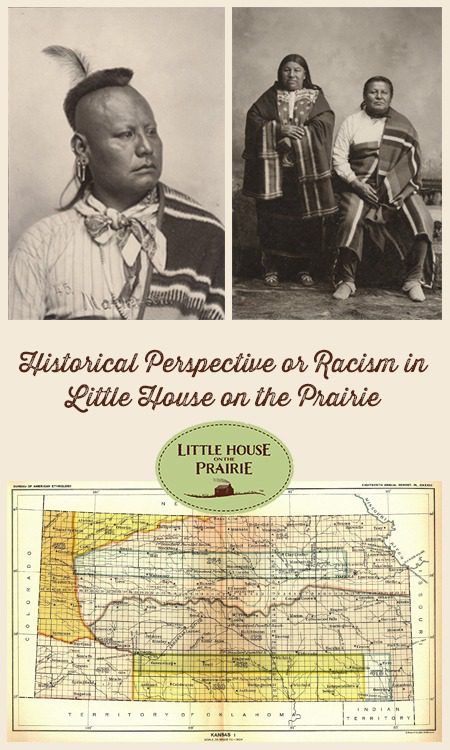
Imagine you are reading a book that you loved as a child, perhaps you are reading it to your young child, or that you are reading it for the very first time. You come across the words “the only good Indian was a dead Indian.” Do you put the book down in horror, shocked by the cultural insensitivity of the author? Do you decry the author as a racist and vow to never read another word? What would you say if you knew that these words are found in the beloved book Little House on the Prairie by Laura Ingalls Wilder?
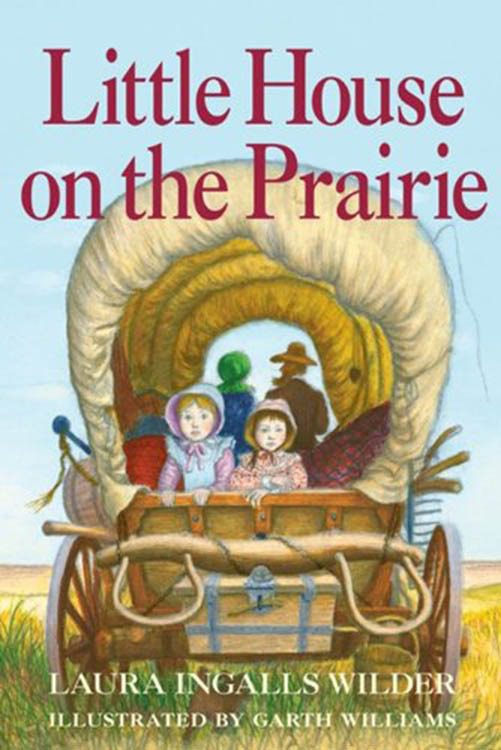
In recent years the Little House books by Laura Ingalls Wilder have been accused of being culturally insensitive and even racist, particularly Little House on the Prairie. In an article with the jarring title “Little Squatter on the Osage Diminished Reserve”, Francis Kaye states “Wilder, writing as honestly as she knew how, spun a tale that, because of her very decency, makes ‘ethnic cleansing’ appear palatable.”
As Amy Fatzinger writes in her dissertation Indians in the House, Wilder raises “a great issue that was still problematic in the 1930s, when Little House on the Prairie was written and remains so today: the Euro-American preemption of lands occupied by Native Americans.” And, Wilder uses the voice of 7-year-old Laura to do so.
The questions then arise, is this because Wilder is culturally insensitive or is she simply writing from her perspective, having been born in 1867 and writing in the 1930s?
Teachable Moments
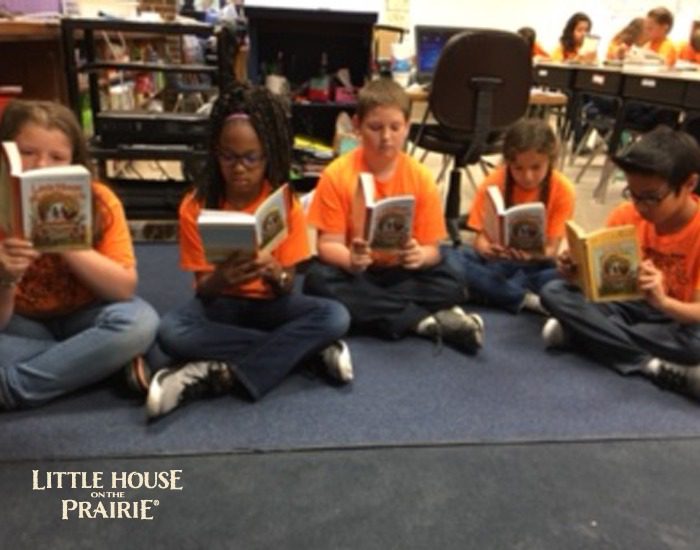
Fifth graders from Cleaveland Traditional Magnet Elementary School in Wichita, Kansas reading Little House on the Prairie.
Reading Little House on the Prairie with children today requires explanation. I call them teachable moments. Before we begin to read the book in my classroom I take a few moments to talk about Wilder’s real life and the historical accuracy of her books. There is the truth as Laura wrote in her books and there is the truth of her real life. After all, Laura was only two when her family left Wisconsin and barely three when they arrived on the prairie. Obviously, she was cast as older than that in both Little House in the Big Woods and Little House on the Prairie. Laura’s stories come from an oral tradition. Her father was a storyteller and Laura herself said that her first books were an attempt to preserve the stories she grew up hearing.
That is not to say that Wilder didn’t do her research as she wrote her books. But, we must remember, this was before the Internet. Wilder lived in rural Missouri, far away from libraries or universities with large reference sections. She did not have information at her fingertips. Laura had to rely on letter writing or long, slow trips to do on-site research as she did for Little House on the Prairie. As a result, some of her writing isn’t accurate. And of course, she was writing historical fiction, not an autobiography. But, to understand Laura’s story, we must understand the history behind the story.
The history behind Little House on the Prairie
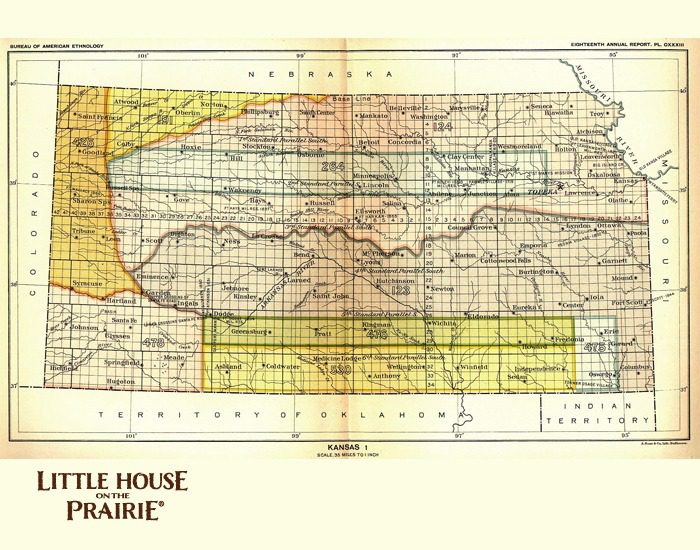
What do readers need to know when reading Little House on the Prairie? I am not going to attempt to give a complete history of the Osage people or the sad legacy of the systematic removal of Native Americans by the government of the United States. Here’s some information that will put things in perspective as you read.
Little House on the Prairie begins with the Ingalls family leaving their little house in Wisconsin. Laura says “They drove away and left it lonely and empty in the clearing…They were going to Indian country.” But, they didn’t go there directly. Charles Ingalls sold his farm in Wisconsin in 1868. He moved his family first to Chariton County, Missouri and then on to Montgomery County, Kansas in late 1868 or early 1869. They were part of an illegal rush of settlers into the Osage Diminished Reserve commonly called Indian Territory. Few people today realize, and perhaps Laura herself didn’t know, that a section of Kansas was once called Indian Territory.
We usually think of Oklahoma as being Indian Territory. However, beginning in 1808, the Osage tribe ceded several tracts of land to the United States government. The Treaty of 1825 established the Osage Diminished Reserve, a section of land about 50 miles wide and 125 miles long in what is now south-central and southeast Kansas. In 1868, the Osage were facing dire economic circumstances. The government had not paid them what was owed due to the great debt incurred by the Civil War and hunting was becoming scarce due to the settlement of the western frontier. The Osage were forced once again to negotiate with the United States and signed the Sturgis Treaty. This treaty said that the Osage would sell their land to the Leavenworth, Lawrence, and Galveston Railroad and buy land from the Cherokee further south and move there.
Squatters on Indian Land
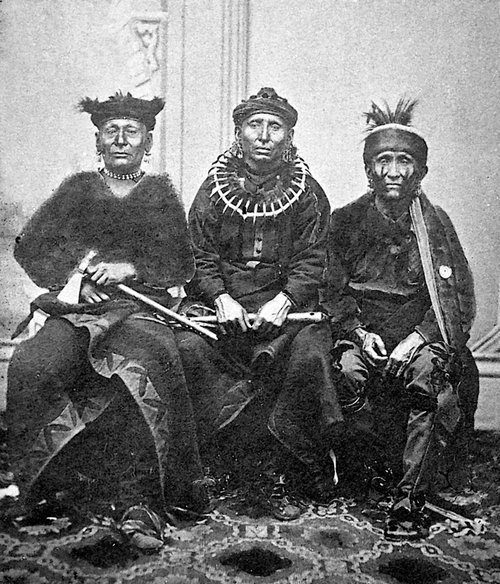
Osage men in traditional dress
News of the impending opening of Indian Territory reached land-hungry settlers back east and caused an illegal land rush into the area. Congress refused to ratify the Sturgis Treaty, fearing a backlash from their constituents who favored free settlement of the land under the Homestead Act of 1862. The Ingalls family was part of the wave of squatters or illegal settlers who entered and established homes in Montgomery County. Whether Pa knew this or not is open for debate, but it is highly unlikely that he would have been ignorant of this fact. In Little House on the Prairie Ma tells Laura that “Pa had word from a man in Washington that the Indian Territory would be open to a settlement soon. It might already be open to settlement. They could not know because Washington was so far away.” Pa was most likely betting that the government would allow squatters to claim homesteads once the Osage were removed.
When most of the settlers arrived in Indian Territory, the Osage people were off on their annual hunting trips further west and it may have appeared that the land was unoccupied. Although the land that Pa chose was obviously next to a well-used trail, he preferred to think of the land as unsettled. In the early pages of Little House on the Prairie, Laura quotes Pa as saying that animals wandered “in a pasture that stretched much farther than a man could see, and there were no settlers. Only Indians lived there.” As did all of the settlers, Pa chose to ignore the fact that the land and everything on it belonged to the Osage people. He freely cut logs to build a house, hunted wild game for food and furs, dug a well and broke the land for farming. When the Osage returned from their trip they found their home and their lands occupied by all kinds of settlers who, in their minds, were stealing from them.
Ma’s fear and the “Minnesota Massacre”
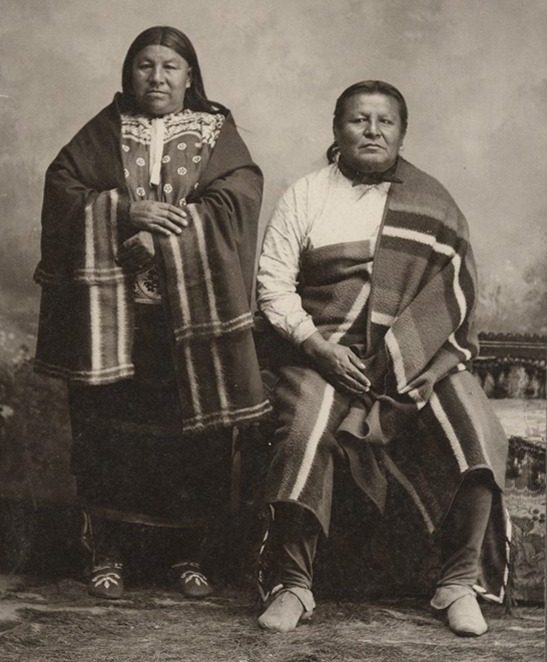
Osage Man and Woman
Under the provisions of earlier treaties, the Osage had the right to charge squatters rent if they wanted to. Laura tells several stories of Indians coming to the Ingalls’ home and demanding food and other goods. They sometimes just came and took whatever they wanted. The Osage saw it as collecting rent. Ma saw it as an intrusion by uninvited guests. Ma was terrified of these visits. Wilder says that Jack, the Ingalls’ bulldog, hated the Indians and Ma said she didn’t blame him. Laura asks Ma, “Why don’t you like Indians, Ma…This is Indian country, isn’t it? What did we come to their country for, if you don’t like them?”; But why was Ma so afraid of the Osage? In order for readers to understand Ma, you need to understand where she was coming from.
Before moving to Kansas, the Ingalls lived near the border of Minnesota and Wisconsin. In late 1862 during the Civil War, many men left their families in Minnesota to fight in the war. Stretched to their limits, local militias were unable to protect their communities. The federal government denied any responsibility for protecting the settlers in Minnesota. The Indians in the area saw this as an opportunity to retake land that they felt belonged to them. The Sioux Uprising or Dakota Wars resulted in the looting and burning of homesteads and the killing of white settlers in the area, including women and children. The newspapers were full of graphic accounts of what was then referred to as the “Minnesota Massacre.” Undoubtedly Ma had read these accounts. Wilder mentions the “Minnesota Massacre” in her account of Mrs. Scott’s hatred for the Osage: “The only good Indian was a dead Indian. The very thought of Indians made her blood run cold. She said, ‘I can’t forget the Minnesota massacre. My Pa and brothers went out with the rest of the settlers…Ma made a sharp sound in her throat, and Mrs. Scott stopped. Whatever a massacre was, it was something that grown-ups would not talk about when little girls were listening.”
Helping children understand
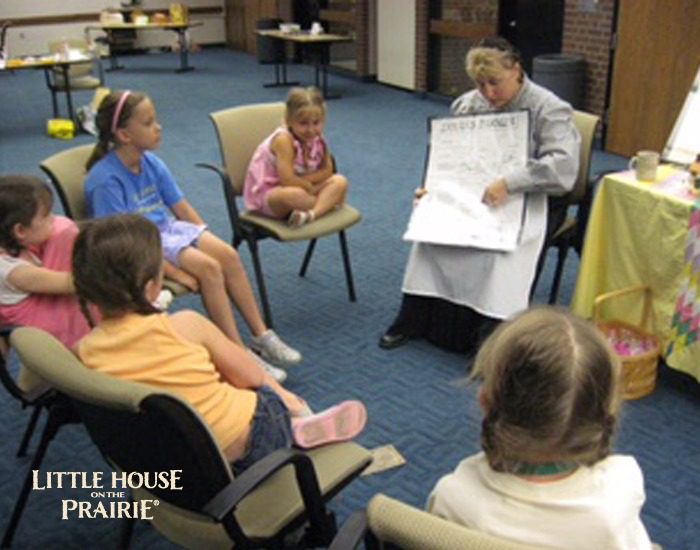
How can we help children develop an understanding of the historical perspective in Little House on the Prairie? I suggest we talk about whether Ma’s fears were justified. Ask if people have an unjustified fear of other races today. Does racism still exist and if so, is it found in every race? This past year my class talked about the riots in Ferguson, Missouri and the media’s portrayal of events there. Discuss how it would feel to have strangers walk into their home uninvited and take whatever they wanted. How would they tell the story to someone else? These kinds of questions will help children understand the historical perspective and that right or wrong, people have their own belief systems, then and now.
Additionally, it is helpful to point out that Wilder presents a more favorable point of view using Pa as a counterpoint. Pa is portrayed as being slightly more accepting of the Indians. For example, in chapter 21 of Little House on the Prairie, Pa must go to Independence to sell his furs. When Ma expresses concern about the Indians being so near, Pa comforts her by saying “They are perfectly friendly’…He often met Indians in the woods where he was hunting. There was nothing to fear from Indians.” Later Pa balances Mr. and Mrs. Scott’s hateful declaration when he makes this statement about Soldat du Chêne: “That’s one good Indian.’ No matter what Mr. Scott said, Pa did not believe that the only good Indian was a dead Indian.”
We may feel today, given our 21st-century sensitivity, that Ma was wrong to fear the Osage or that Mr. and Mrs. Scott were racist. And we are right, in our times they are. But I suggest that rather than banning books or refusing to read them, we use them as a platform for examining the history of the United States. What better way to learn our history than by reading a classic like Little House on the Prairie and using it as a platform for discussion?
Recommendations from the website editors
We recommend reading Bury My Heart at Wounded Knee: An Indian History of the American West by Dee Brown. The chapter about “Little Crow’s War” provides important context to the Dakota uprising in Minnesota. Other worthwhile books are Through Dakota Eyes: Narrative Accounts of the Minnesota Indian War of 1862 edited by Gary Clayton Anderson and Alan R. Woolworth and Over the Earth I Come: The Great Sioux Uprising of 1862 by Duane P. Schultz.
There have been many fascinating books written about Laura Ingalls Wilder and her daughter and editor Rose Wilder Lane. We invite you to visit our Recommended Reading section to find books for children and young adults and for adults. These books explore different areas of Wilder’s life and work, often bringing new and unexpected interpretations to a wide range of topics. They include classic titles and newer works.
You may also be interested in an entertaining and educational documentary film about Laura Ingalls Wilder, which is appropriate for all ages. The DVD contains an interesting bonus featurette about Native Americans and African Americans on the prairie.
An educator since 1983, Dr. LauraMoatsMcLemore was destined to a lifelong love of Laura Ingalls Wilder. Her mother readLittle House in the Big Woodsin second grade and named her second daughter after the beloved author. McLemore portrayed Laura Ingalls Wilder for the first time in 1993 and shared Wilder’s life across the Midwest. She was a fifth-grade teacher and resident of Maize, Kansas before her passing in July, 2023.
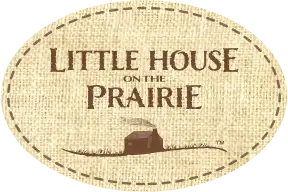

A better title:
“Illegal Squatters stealing everything on the Osage Diminished Reserve.”
Your article was disappointing. Growing up I loved the books. My mother made us bonnets. Daily my sisters and I played settlers, hooking up the bouncy horse to the picnic table for our covered wagon.
Until this article, I thought the treasured books could be taught with sensitivity and historical perspective.
Now I’m unsure. It won’t work taught this way.
If one wants the books read in class, then first spend the fall reading about native Americans – authored by native Americans. Have students research and give reports with pride for the people who owned the land for centuries, for thousands of years.
Then read the stories. They can enjoy Laura’s spirit. They can also recognize and be shocked, and grieve, the Osage’s loss of land and life.
I loved it.
I love reading all the little house books and all the extended ones included. They take me back to a land of used to be, and though sunshine didn’t shine all the time there were shadows too, just as in modern times. There’s nothing wrong with her books, it’s just that people throughout the years change expressions. Words that were appropriate when Laura wrote her books were accepted as normal however some of those words are not accepted now because people change the meanings. Whatever ways you look at it , it’s still all about history and those were times to be studied and cherished with fond thoughts just as school history books teach us about the old ways of life and we can measure progress by how many steps we walk in our minds to gain a clearer understanding of today and tomorrow’s to come.
As a Native American (Sioux) I would say that while yes, we have to look at the context, it doesn’t mean that the beliefs back then were not still racist. The “oh it was a different time” approach is interesting…except for the fact that people today refuse to see how those beliefs are still affecting Natives now. From my experience as a Native/White mixed person is that white people tend to only see things from THEIR perspective and that often they lack empathy. That is a cultural thing based on the “perfectionism” of white supremacy and the demonization of those who are not white. White people need to understand how white supremacy IS their culture. If they were to research how white supremacy affects THEM negatively too…maybe, they would finally LISTEN.
Thank you for sharing your perspective and feedback. We welcome hearing from diverse voices and encourage our readers to explore the additional book recommendations at the end of the article. We will continue to gather more resources in collaboration with Native American scholars.
After reading the little house books for the first time at the age of 46, I was somewhat surprised by the portrayal of Native Americans and African Americans in the books, and did an internet search to see what the general reaction was to these passages. I did not know beforehand about the removal of the author’s name from the award, or the controversy. I simply had never read them as a child and wanted to see what I had missed out on.
The controversial passages were a reminder to me of just how far we have come in my lifetime. I was born in the mid 1970’s, and experienced some of the racial bigotry, even within my own family. There is no doubt that it exists and was ingrained into American life in past generations.
The idea that we should wash and rewrite history to somehow correct an injustice is not just ridiculous, but is also dangerous! The past is what it is. Facts are facts. In the entire recorded history of humankind, there has been bloodshed and a constant narrative of one people overpowering another to take what they wanted. This is human nature, and it is a problem that will never be completely solved.
But, if a civil society is to exist, then we must become students of the past and do our very best to understand the causes of these horrors, and attempt to correct our thinking in the present. The way forward is not to forget what has happened, or to try and account for the injustice of past generations (as if we could really right every wrong), but to become people who learn and think and understand human motivations and deal with that problem in our present time.
Personally, I have tried to do exactly that in my own life. While I heard racial slurs and a bigoted mindset from older family members from a young age, I recognized the error, and decided to throw out that mentality to the best of my ability.
That’s really the question: As a nation, do we want to continue on in a pattern of hate, or perpetual blame and victimhood, or forgive and change and move forward? Because we can’t change what happened in previous generations, and we really can’t even apologize for them. It was simply the ugly truth of that time.
With that said, let’s try and understand the perspective from which these books were written. We can all understand that the narrative from a conquering people will definitely be biased by their own perspective, just as every single piece of literature has been since the beginning of time (every work is written from a particular flawed, human perspective). The wise thing is to gather the facts (as ugly as they may be), process them through our current knowledge and experience, and make the right decisions in our own time. Removing or washing the past will only weaken our ability to do that.
I stumbled on this while looking into why Wilders’s name was stripped from the award. I’ve never read any of the Little House books, because I felt that weren’t for me. When I was young, it was difficult to find positive representation of BIPOC and I knew these books wouldn’t provide it. To see so many comments disregard the impact of the language and treatment of Native characters in the stories, as well as explain away the obvious racism from key characters, is appalling though not surprising. Several people commented that we can’t hold Wilders or the characters to the standards we have today, because back then racism and hate were not only commonplace, they were acceptable. Except it wasn’t acceptable to those who had to bear it. And if we don’t want old works to be held to today’s standards, we shouldn’t keep them around, because those words WILL hurt people.
Thank you for your perspective.
THANK YOU. I too stumbled across this as I was researching more about Wilder, and of course it was written by a white woman. The whitewashing of Native history is apparent even in this blog post. Take, for instance, the fact that she says “I am not going to attempt to give a complete history of the Osage people or the sad legacy of the systematic removal of Native Americans by the government,” yet later has no problem going into a detailed history lesson to describe the Minnesota Massacre, an event which negatively affected her heroine’s family. Similarly, comments like “we usually think of Oklahoma as being Indian Territory” does nothing but reinforce untrue stereotypes about where Native Americans live and just how much of “our” land was stolen from them. The comments on this post are an echo-chamber of women who had warm fuzzies while reading these books as children and are now desperately clinging to reasons to justify the books’ continued presence in American children’s lives. Here’s the problem with using these books to “learn our history and use them as a platform for discussion”: you simply don’t get to use a white person’s racist perspective as the starting point. This is on par with saying that “Mein Kampf” should be read in schools as the basis for teaching about the Holocaust. I have to wonder, is the author friends with any direct descendants of the Osage people? Do they agree with her that this is the best way to teach young minds about the ugly history of Westward expansion? Somehow I think the answer is no.
Thank you for sharing your perspective and feedback. We welcome hearing from diverse voices and encourage our readers to learn more about Native American history. In addition to the book recommendations described at the end of this article, we are gathering more resources in collaboration with Native American scholars.
Well said Teana! ????????. Even this article some problematic statements. Either the property was or was not theirs – there is no “felt”.
I am part American Indian and I loved them as a kid. Nice refuge from parents who fought all the time.
Very good insight to these books. I grew up reading the books and I still read them since it offers a glimpse into a world that we just can’t experience. When I was a child it did not occur to me that the books were racist since she was repeating what she heard or remembered hearing as a way of preserving the stories. As an adult I cringe when I read the books but I have to remind myself that society has made progress and I’ve grown as a person to recognize racism. It doesn’t stop me from reading the books since I still view them as a perspective made by Laura Ingalls Wilder and she is writing about those times. I applaud you for stating that rather than ban the books it is better to introduce children to historical books and talk about the views of the times and what progress has been made and what we need to do to continue to combat racism in our society. One last observation, I took from Laura’s books that she portrayed or tried to portray first nations with dignity and provided positive examples, such as the Long Winter and how an elder tried to help the townspeople by warning of the impending winter.
Most fear of someone “different”, or another color, than ourselves, is because people are afraid, of the unknown. If we haven’t met, or heard the good things, about a certain race, or someone from
Another country, we are sometimes Leary. Frankly, I love to meet people from other countries, learn their ways, and for the most part, taste “their” food. It’s just like people were, and some still are, afraid of those who ride motorcycles. Because, of what they read, and heard about “The Hell’s Angels”. Motorcyclist are ordinary, people. You don’t find any, of them, any worse than someone, who drives a car. Fear, is in the mind, caused by the “unknown”
Your comments are very interesting. I began reading the Little House books when I was 9-10 years old. I am now 72. I never really found any thing really racist in the books. Concerning Caroline Ingalls, I think she just feared what she did not know. And of course every treaty the U.S. Government made with Native Americans was never upheld. To this day it makes me sad that Native Americans were forced onto reservations where they were basically starved, cheated and forced to give up their traditions, native tongues. One thing I do love about the books is the way Laura described how her parents worked, to build a small cabin, raise crops, it is amazing that some children find the books boring. I think they are jaded by how very tough pioneer life was. I remember traveling across country in 1953 and having no air conditioner in the car. I cannot imagine traveling across country by wagon!
Not only were native Americans starved and forced into reservation. A lot of them was slaughtered and some of tribes are even extinct . That is what European when they came here. He not only massacred men women and children. They gave them disease clothing and blankets. And make sure they didn’t surviv . native Americans that fought back . I believe we still owe the native American debt. As we all the African-American
I wonder if this is the reason why Michael Landon really didn’t want to do this story. I never look deeply into it that story,but I will now.
I love those books. My mother read them to me when I was a child. When my two are older I will read them the books at night. Reading them for the first time in years I am once again reminded of the fact that 2019 is vastly different than the 1880s.
I think reading the books with children and taking the opportunity to use some of the racist viewpoints of characters to open up a discussion about race in America is a great thing. Teachers should do this. These things should not be swept under the rug or ignored. While one may assume that we’re all going along in 2019, you never know what children are being exposed to at home, as evidenced by our current rise in racially motivated attacks.
Loved: “What better way to learn our history than by reading a classic like Little House on the Prairie and using it as a platform for discussion?”
Well said.
I cannot express how refreshing it is to read the previous comments. I agree with them completely. If we do not know the true history of our nation’s/culture’s past, how can we prevent ourselves from making the same mistakes? Let us use common sense, face our past errors honestly, and not doom ourselves to repeat them Explaining to children that during this time, the settlers did not understand the cultures of the various Native tribes and would say things and make sad choices out of fear is a simple truth every child can appreciate.
When I read historical fiction and non-fiction, I am enjoying a journey on a time machine. To read the thoughts, beliefs and experiences of people who once were alive and living their lives every minute of every day is fascinating. It’s not my place to judge or justify them…but rather, to understand them from their perspective, to learn from them and mostly to enjoy the stories.
We cannot and should not rewrite history. Conflicts between peoples were and are real and all readers should be able to read about these issues and, of course, be able to question values and mores of the times, from the author’s perspective. From the author’s “perspective” is the important part. How else would we learn about the conflicts, thoughts, and outcomes of these situations that will occur in all our lives; all of them shaping history? We don’t all think alike, nor do we always agree with others’ views of our world. This is how we develop our viewpoints. This is why it is important to be present when our children are reading things that may not reflect our own values. Open dialogues should be part of book discussions with children, always encouraging them to share their questions and views.
I enjoyed reading your thoughts.
Why are some people trying to erase history and rewrite to suit their views??? I have the whole collection of Little House on the Prairie books. I have read them so many times! I read them to our son when he was little. We certainly enjoyed the TV show. The stories in the books are told through the eyes of an intelligent, curious, answer seeking young girl who lived a life none of us are now living. Yes, times have changed, and attitudes for the most part have changed, but one should never try to change history and what life was like back then. LEARN from history! These books should be read, shared, discussed now and with future generations.
Thank you for this article! This is the second year I’ve taught Little House on the Prairie in my 5th grade class and it has opened up some very frank and meaningful conversations about prejudice, racism, and historical context. I teach it in the spring. In the fall, I teach The Birchbark House, by Louise Erdrich. As we read Little House, we stop often and reflect on the similarities and differences between the main characters, their families, and their life styles.
I’m a long-time Little House fan from Australia. As an adult I have always read the books with a historical perspective and as being a product of their times.
This article made me question why I had never questioned the reason the Ingalls Family settled on land that didn’t belong to them, even when I was a child and didn’t have a great knowledge of history. My conclusion is that Australia has its own entrenched history of displacing indigenous (Aboriginal) people that by the time I read the books when I was about 8 years old I just never questioned it. I already knew that was just what had happened. As an adult I find that really sad.
I enjoyed this thought-provoking article and wanted to let you know that this particular teachable moment is applicable in other countries with a history of colonialism.
Great article. I find it appalling that people fail to understand cultural relativism and how it may be used to better understand history and the interaction of cultures. In a relative sense, there are few heros and villains. Most act on the belief that they have the moral superiority. Referring to something by its known name is simply good communication. Re-naming an event does not give one side or the other greater legitimacy. From the perspective of the white settlers, I am sure it did seem like a massacre. From the perspective of the Indians, I’m sure it seemed like a righteous resistance.
Cultural relativism is fine but try to realize that the ORGIN of it is coming from a WHITE SUPREMACY perspective. When people realize THAT we will get somewhere. Just because “everyone has a side” doesn’t mean that genocide is right. Why can’t I as a Native Person find information about Natives that hasn’t been filtered through the white perspective? I am tired of white people trying to put the horrors of colonialism in the same category as people trying to protect their way of life. That they had for thousands of years. Sorry, that is white washing.
Thank you for sharing your perspective and feedback. We welcome hearing from diverse voices and encourage our readers to explore the additional book recommendations at the end of the article. We will continue to gather more resources in collaboration with Native American scholars.
I when I was reading “Little House on the Prairie ” for the first time as a young girl about 22 years ago, I was concerned about Ma’s prejudices.
I’m glad to see it addressed.
Laura, this is a wonderful response to the racism in the books. I’m working on addressing this now.
Very well done. Written by a fine education.
Very interesting article! Excellent work!
Laura, you never fail to amaze me. You use your remarkable, God-given talent for writing in such interesting ways. I’m privileged to call you my friend and fellow teacher.
Thank You! Finally, an article about the 1862 Sioux Uprising and how it relates to Little House! My ancestors are survivors who fled to New Ulm. I have their handwritten marriage certificate from 1860 in Brown County. Since I learned that story, I’ve understood Ma’s feelings better and why they make sense given the time in history. I’m not a writer so thanks for finally explaining it so simply.
Excellent read Laura!
When I was 8-9 in the ’70’s, my mom read the books to me, and I re-read them many times myself. I never thought her remarks about the Indians were “racist” as I was seeing them through the eyes of another naive 8 or 9 year old girl. I’m glad this is being used as a teaching resource to help kids understand cultural differences and conflicts and be more open minded. Great article!
I enjoyed it vry much. I am glad I wasn’t born in those days!
Very interesting and excellent article.
Well- written! Proud of you my friend. I’m glad we share a love for the Ingalls.